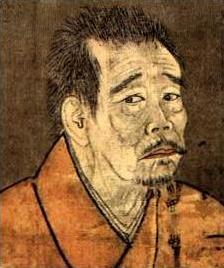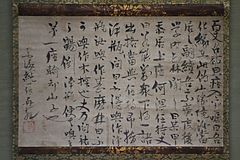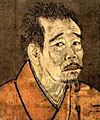Ikkyū facts for kids
Quick facts for kids Ikkyū |
|
|---|---|
 |
|
| Religion | Buddhism |
| School | Rinzai |
| Personal | |
| Born | 1394 Kyoto, Japan |
| Died | 1481 Kyōtanabe, Kyoto |
| Senior posting | |
| Title | Zen Master |
| Predecessor | Kaso |
Ikkyū (一休宗純, Ikkyū Sōjun, 1394–1481) was a very unique and independent Japanese Zen Buddhist monk and poet. He had a big influence on Japanese art and literature. He helped mix Zen ideas into these areas. Ikkyū also impacted Zen itself. He often challenged traditional religious rules and ideas.
Contents
Biography of Ikkyū
Ikkyū's Early Life
Ikkyū was born in 1394. His birthplace was a small area near Kyoto. Many believe he was the son of Emperor Go-Komatsu. His mother was a noblewoman of lower rank. She had to move to Saga, where Ikkyū grew up.
When he was five, Ikkyū was sent away from his mother. He went to a Rinzai Zen temple in Kyoto. This temple was called Ankoku-ji. There, he began his training as a young monk. The teachers at the temple taught Chinese culture and language. This teaching method was known as Gozan Zen. Ikkyū was given the name Shuken. He learned a lot about Chinese poetry, art, and literature.
Ikkyū's Zen Training
At age thirteen, Ikkyū went to Kennin-ji in Kyoto. He studied Zen under a famous priest named Botetsu. During this time, Ikkyū started writing many poems. His poems were not always traditional. He openly criticized the leaders at Kennin-ji. He was unhappy with the social differences he saw. He also felt there was not enough zazen (meditation) practice.
In 1410, when he was sixteen, Ikkyū left Kennin-ji. He then went to the temple Mibu-dera. An abbot named Seiso lived there. Ikkyū did not stay long at Mibu-dera. Soon, he found himself at Saikin-ji. This temple was in the Lake Biwa area. He became the only student of an abbot named Ken'o.
It seemed Ikkyū had finally found a true teacher. Ken'o taught Rinzai Zen as Ikkyū believed it should be. Ken'o's teaching style was not always predictable. He strongly believed in the importance of zazen. In 1414, when Ikkyū was 21, Ken'o passed away. Ikkyū performed funeral rites for him. He also fasted for seven days to honor his teacher.
Ikkyū soon found a new teacher. This was Master Kaso at Zenko-an. Zenko-an was a branch temple of Daitoku-ji. Kaso's style was very similar to Ken'o's. For years, Ikkyū worked hard on assigned kōan (Zen riddles). He also made dolls for a local merchant in Kyoto.
In 1418, Ikkyū was given a special kōan. It was Case 15 from the Mumonkan. This is a famous collection of 49 kōan. One day, a group of blind singers performed at the temple. Ikkyū was deeply moved by the music. While listening, he understood his kōan. Kaso recognized his understanding. He gave Shuken the Dharma name Ikkyū. This name roughly means 'One Pause'.
In 1420, Ikkyū was meditating on a boat. He was on Lake Biwa. The sound of a crow suddenly sparked a moment of deep understanding. This moment is called satori. Kaso confirmed this great enlightenment. He then granted Ikkyū inka. This is a seal of approval for his Zen understanding.
However, a more senior student named Yoso became jealous. Yoso later took over the monastery. In Ikkyū's poems, Yoso is shown as someone too focused on money. He seemed to use Zen to make the temple richer.
Life as a Wandering Monk
Ikkyū sometimes behaved in ways that surprised others. He would often upset Kaso with his comments and actions. Because of this, Kaso gave the inka to Yoso. He made Yoso his official successor. Ikkyū quickly left the temple. He lived for many years as a wandering monk.
He was not alone during this time. He had a group of well-known artists and poets as friends. Around this period, he formed a close bond with a blind singer named Mori.
Ikkyū worked to live Zen outside of formal religious places. Later, the Ōnin War destroyed Daitokuji. Ikkyū was chosen to be the abbot late in his life. He took on this role, though he was not eager to. This placed him firmly in an important Zen lineage. In 1481, Ikkyū passed away. He was 87 years old.
Ikkyū's Lasting Impact
Ikkyū is one of the most important figures in Zen history. He was also very unique. For Japanese children, he is a folk hero. He is seen as mischievous and always outsmarting his teachers. He even outsmarted the shōgun. This is partly due to many oral stories. It is also because of the popular animated TV series Ikkyū-san.
In Rinzai Zen tradition, he is seen as both a rebel and a saint.
He is often named as a main influence on the Fuke Zen sect of Rinzai Zen. He was one of the most famous flute-playing monks. These monks wandered Japan in medieval times. The music piece "Murasaki Reibo" is said to be his. He is also credited with influencing the Japanese tea ceremony. Ikkyū is known as one of medieval Japan's greatest calligraphers. He was also a skilled sumi-e artist.
Ikkyū in Popular Culture
- Toei Animation created the historical comedy anime series Ikkyū-san. It was based on Ikkyū's early life at Ankoku-ji Temple. The show first aired on TV Asahi from 1975 to 1982. Kimio Yabuki directed the anime. Many writers worked on it. The series was popular with all ages in Japan and across Asia. In 1976, a movie was also released. It was part of the Toei Manga Matsui film festival.
- In the anime OVA Read or Die, a clone of Ikkyū appears. He leads the villains. All the villains are clones of famous historical figures.
- In the book On the Warrior's Path, author Daniele Bolelli calls Ikkyū his "hero and philosophical role model". He also wrote about Ikkyū's life in his book 50 Things You're Not Supposed to Know: Religion. Ikkyū's story was also featured in two episodes of the podcast History on Fire.
- The Japanese manga author Hisashi Sakaguchi wrote a life story of Ikkyū. It is called あっかんべェ一休, or 'Akkanbe Ikkyu'. It follows the popular stories about him. This manga has been translated into several languages.
- In the manga Afterschool Charisma, a clone of Ikkyū is a classmate. This special school is full of clones of famous historical figures.
- Comic author Tom Robbins identifies Ikkyū as his "idol".
- In the anime/manga Eyeshield 21, Hosakawa Ikkyū (細川一休) is the name of a talented cornerback. He plays for the Shinryuji Naga American football team.
- In the PSP game GA Geijutsuka Art Design Class Slapstick Wonderland, the children's story version of Ikkyū can be chosen. It is a theme for a picture book project.
- Kleenex Girl Wonder wrote the song Don't Cry, Ikkyu about Ikkyū.
- In the Kamen Rider Ghost DVD special, Ikkyu Eyecon Contention! Quick Wit Battle!!, Ikkyū's spirit helps the hero. He helps Takeru Tenkuji/Kamen Rider Ghost. This allows him to use his monk-like Ikkyū Damashii form.
- Wednesday Campanella has a song and music video called Ikkyu-san.
Images for kids
See also
 In Spanish: Ikkyū para niños
In Spanish: Ikkyū para niños



